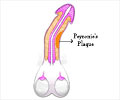First genetic risk factor for erectile dysfunction (ED) has been identified. The ED locus is located adjacent to the SIM1 gene. The SIM1 gene can be targeted for developing new pharmaceutical therapies for ED.
- Erectile dysfunction (ED) risk factor gene has been identified for the first time
- The ED gene locus is located adjacent to the single-minded gene homolog 1 or SIM1 gene, the activity of which can be modulated by the ED gene
- The SIM1 gene can be targeted for developing novel therapeutic and preventive strategies for ED
Read More..
Current Therapies for Erectile Dysfunction (ED)
Several therapies exist for ED. These include medicines like Sildenafil Citrate, which was developed in 1998 and was the first and most popular drug for ED. Most of the medicines for ED are based on correcting defects of vascular, hormonal or neurological origin. Besides medications, other therapies also exist, which include extracorporeal shockwave therapy (ESWT), sex therapy or the use of a penile prosthesis. Besides the above causes of ED, it has been long suspected that there is a genetic cause for ED too. But this has not been found, until now.Study Details
Scientists from Kaiser Permanente mapped the exact position (genetic locus) of the gene responsible for ED in the human genome. The gene is located adjacent to the single-minded gene homolog 1, commonly known as the SIM1 gene. Dr. Eric Jorgenson, PhD, a Research Scientist at Kaiser Permanente Northern California’s Division of Research and the lead author of the study said: “Identifying this SIM1 locus as a risk factor for ED is a big deal because it provides the long sought-after proof that there is a genetic component to the disease.” He added, “Identifying the first genetic risk factor for ED is an exciting discovery because it opens the door for investigations into new, genetic-based therapies.”The scientists performed a genome-wide association study in two large and diverse cohorts in order to find a genetic risk factor that could be responsible for ED.
- The first cohort was the Genetic Epidemiology Research on Adult Health and Aging (GERA) cohort, which included 36,648 men. This cohort is a part of the Kaiser Permanente Research Bank, which includes bio-specimens from over 320,000 individuals.
- The second cohort was the UK Biobank, which included 222,358 men. This second cohort was used to verify the responses of the GERA cohort to a structured questionnaire that was aimed at assessing the condition of these individuals.
Study Findings
The study found that variations in the SIM1 gene locus accounted for 26 percent increased risk of ED. Importantly, this risk excluded other causes of ED. The findings were confirmed by the UK Biobank cohort.Dr. Stephen Van Den Eeden, PhD, a Research Scientist at the Kaiser Permanente Northern California’s Division of Research and the senior author of the study, said: “This significant advance in our understanding of ED is made possible by the unique ability of the Kaiser Permanente Research Bank to link detailed questionnaires, electronic health records, and genetic data on such a large population.”
The study confirmed that the SIM1 locus was indeed a risk factor for ED, whether the disorder was established based on prescribing history, clinical diagnosis or patient self-reporting.
The biological role of this ED locus was established based on the function of the SIM1 gene, which is a component of a signaling pathway that plays a major role in the regulation of body weight and sexual function.
The ED risk locus was found to interact with the promoter of the SIM1 gene, which in turn alters the function of the enhancer, sometimes referred to as the master gene regulator.
The study suggests that since the ED risk locus shows an enhancer activity and interacts with the SIM1 promoter, it is very likely that it causes the differential expression of the SIM1 gene, turning it “on” or “off” as and when required, just like a light switch.
Conclusion
The study highlights the fact that the SIM1 locus could be a potential target for the development of new therapeutic strategies for ED. This is particularly important, since almost half of all men suffering from ED don’t respond to currently available medications.Dr. Hunter Wessells, MD, Chair of Urology at the University of Washington School of Medicine, a co-author and one of the principal investigators of the study, said: “This study points to a new research direction for ED that could help us identify other key genetic variants that trigger the disease and lead to investigations to better understand the precise mechanisms by which they operate.” He added: “Hopefully, this will translate into better treatments and, importantly, prevention approaches for the men and their partners who often suffer silently with this condition.”
Notes
- Genome: The complete set of genes or genetic material present in a cell or organism.
- Cohort: A group of people with a shared characteristic.
- Enhancer: A short region of DNA to which proteins bind to increase the transcription of a particular gene.
- Promoter: A region of DNA that initiates transcription of a particular gene.
References:
- First Genetic Risk Factor for Erectile Dysfunction Identified - (https://share.kaiserpermanente.org/article/first-genetic-risk-factor-for-erectile-dysfunction-identified/)
- Erectile Dysfunction in the Elderly Male - (https://www.ncbi.nlm.nih.gov/pubmed/28861293)
Source-Medindia
















